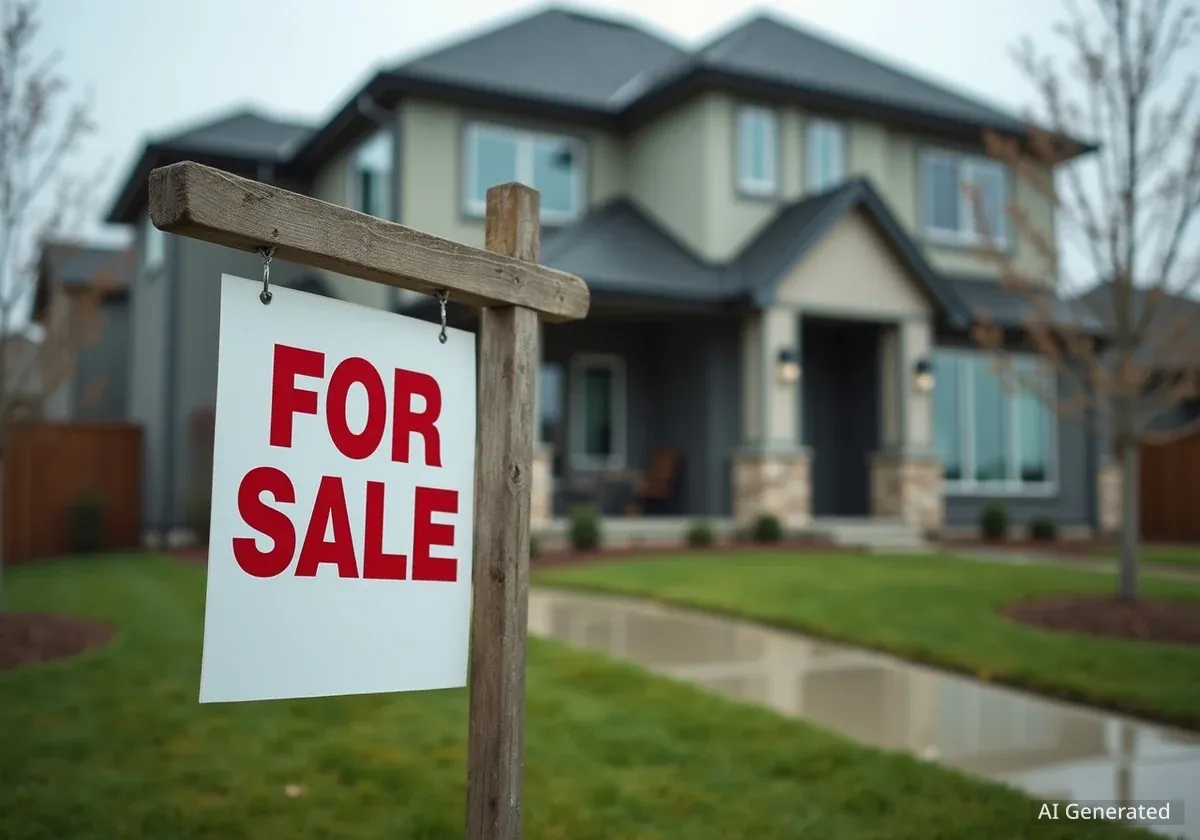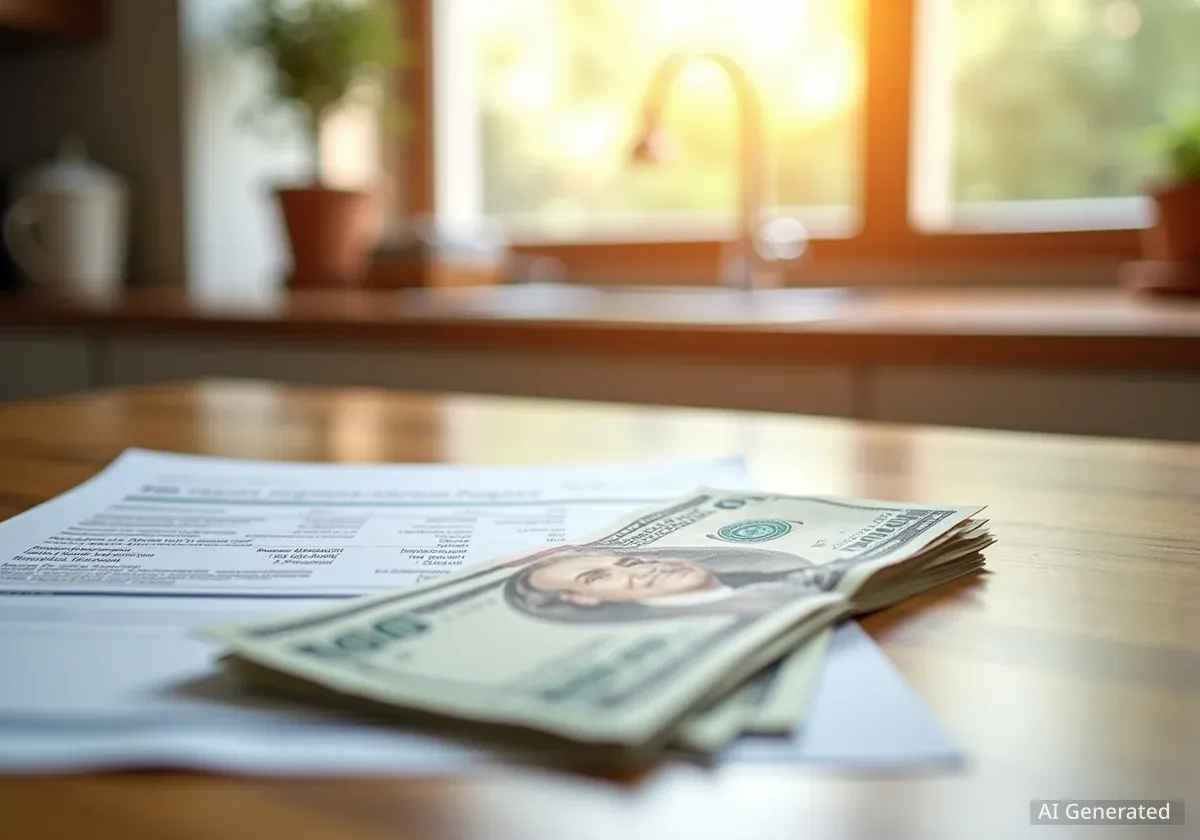The United States housing market is experiencing a significant slowdown as mortgage rates climb to their highest levels in over two decades. This rapid increase in borrowing costs, driven by the Federal Reserve's monetary policy, has pushed many potential homebuyers to the sidelines, leading to a notable drop in sales and a deceleration in price growth.
Data from the National Association of Realtors (NAR) shows a consistent decline in existing-home sales, indicating that the once red-hot market is entering a new phase of correction. Affordability has become the primary challenge for buyers, with the cost of financing a home purchase rising dramatically over the past year.
Key Takeaways
- Mortgage rates have more than doubled, reaching levels not seen in over 20 years, directly impacting buyer affordability.
- Existing-home sales have fallen for several consecutive months, signaling a clear cooling trend in the market.
- While price growth is slowing, a major price crash is considered unlikely due to persistently low housing inventory.
- The Federal Reserve's actions to combat inflation are the primary driver behind the surge in borrowing costs.
Federal Reserve Policy and Its Impact on Mortgages
The primary driver behind the surge in mortgage rates is the Federal Reserve's aggressive monetary tightening campaign. To combat multi-decade high inflation, the central bank has raised its benchmark federal funds rate multiple times. While the Fed does not set mortgage rates directly, its policy actions heavily influence them.
The interest rate on a 30-year fixed-rate mortgage, the most popular home loan product in the U.S., closely follows the yield on 10-year Treasury bonds. These yields rise when investors anticipate further Fed rate hikes and persistent inflation, which translates directly to higher borrowing costs for consumers.
Understanding the Federal Reserve's Role
The Federal Reserve's monetary policy decisions are aimed at achieving its dual mandate: maximum employment and stable prices (typically a 2% inflation rate). When inflation runs too high, as it has recently, the Fed raises interest rates to cool down economic activity, reduce demand, and bring prices back under control. This has a direct and significant effect on interest-sensitive sectors like housing.
This policy shift marks a stark contrast to the pandemic era, where record-low interest rates fueled a housing boom characterized by intense bidding wars and rapid price appreciation. Now, the market dynamic has fundamentally changed.
Buyer Affordability Crisis
The most immediate consequence of higher mortgage rates is a sharp decline in housing affordability. For the average homebuyer, the increase in rates translates to a significantly larger monthly payment for the same priced home.
The Numbers Behind the Slowdown
Consider a buyer purchasing a median-priced home. A year ago, with rates around 3%, the monthly principal and interest payment was manageable for many. Today, with rates hovering near 7%, that same payment has increased by hundreds of dollars, effectively pricing a large segment of the population out of the market.
According to real estate brokerage Redfin, a homebuyer with a $2,500 monthly budget can afford a home worth nearly $150,000 less today than they could a year ago when rates were lower. This illustrates a 30% decline in purchasing power due to rising rates alone.
This affordability squeeze disproportionately affects first-time homebuyers, who often have smaller down payments and less financial flexibility. As a result, many are forced to either rent for longer, seek smaller homes, or move to more affordable regions.
"We've moved from a market defined by a shortage of homes to a market defined by a shortage of buyers who can afford them. The sticker shock from the monthly payment is real, and it's the single biggest factor cooling demand right now," stated a senior economist at the Mortgage Bankers Association.
Slowing Price Growth and Declining Sales Volume
The drop in demand is having a clear effect on key market indicators. Both the pace of sales and the rate of price appreciation are slowing down from the frantic levels seen in 2021.
The National Association of Realtors reported that existing-home sales have declined for more than ten consecutive months. This sustained drop in transaction volume is a direct result of buyers pausing their searches in the face of high costs.
At the same time, home price growth has moderated significantly. While prices are not falling on a national level, the double-digit year-over-year gains are a thing of the past. Some of the most overheated markets, particularly in the West, are now experiencing modest price corrections.
Regional Market Variations
The housing market's response to higher rates is not uniform across the country. Markets that saw the most extreme price surges during the pandemic are now cooling the fastest. These include cities like:
- Boise, Idaho
- Austin, Texas
- Phoenix, Arizona
In contrast, more affordable markets in the Midwest and parts of the South are showing more resilience, as their lower price points still offer a path to homeownership for some buyers.
Inventory Remains a Complicating Factor
Despite the sharp drop in demand, a widespread crash in home prices is widely considered unlikely by most economists. The main reason is the persistent shortage of housing inventory.
For over a decade, the U.S. has under-built homes relative to population growth. This structural deficit means there are still not enough homes available for sale to meet long-term demand, providing a floor for prices.
The 'Lock-In' Effect
Another factor keeping inventory low is the "lock-in" effect. The vast majority of current homeowners are locked into mortgage rates below 4%. They have little financial incentive to sell their homes and move, as doing so would mean taking on a new mortgage at a much higher rate. This reluctance to sell is keeping the supply of existing homes on the market historically tight.
This dynamic creates a complex situation: while demand is weak, supply is also constrained. This balance is preventing the kind of sharp price declines seen during the 2008 financial crisis, which was characterized by a glut of available homes.
Future Outlook for the Housing Market
Experts predict the housing market will continue its correction phase in the coming months. The market's trajectory will largely depend on the future path of inflation and the Federal Reserve's corresponding policy decisions.
If inflation shows signs of easing, the Fed may slow or pause its rate hikes, which could provide some stability for mortgage rates. However, most analysts agree that the era of ultra-low rates is over. The market is now adjusting to a new normal where borrowing costs are higher, and affordability will remain a central theme for the foreseeable future.





